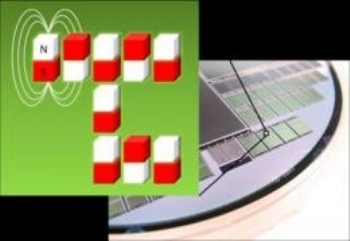A recent research performed by electrical engineers at the University of California, Berkeley reports that future computers will deploy magnetic microprocessors that intake lesser quantity of electrical energy in comparison with computers of today that use silicon-based microprocessor chips.
 Nanomagnetic computers use tiny bar magnets to store and process information. The interactions between the polarized, north-south magnetic fields of closely spaced magnets allow logic operations like those in conventional transistors.
Nanomagnetic computers use tiny bar magnets to store and process information. The interactions between the polarized, north-south magnetic fields of closely spaced magnets allow logic operations like those in conventional transistors.
It elaborates that unlike silicon microprocessors that depend on moving electrons or electric power and waste a lot of energy, the magnetic microprocessors will deploy magnets of nanometer-size like that of small refrigerator magnets for operations such as switching, logic and memory will require no moving electrons. The research work received support from Western Institute of Nanoelectronics and NSF.
The research published by Jeffrey Bokor, a Professor from UC Berkeley and Brian Lambson and David Carlton graduate students from the University, mentions that magnetic microprocessors will scatter only 18 mEV of energy per every operation at room temperature level, a minimum allowed limit mentioned in the second law of thermodynamics known as Landauer limit, which is nearly 1 million times lesser energy consumption when compared to silicon microprocessor computers. The research explains that in the absence of moving electrons as in silicon computers, the magnetic computers can incorporate magnets to process and store the information and can be packed very close to each other to enable interaction between them to perform functions and store information.
The researchers utilized nanomagnets in the size of 100 nm x 200 nm long as logical devices to construct magnetic memory. The bar magnets with identical north-south polarity were used in up-or-down pole orientation to symbolize 0 and 1 binary characters of computer memory. Also, the multiple numbers of nanomagnets when added together, the north and south pole interactions of the magnets through dipole-dipole forces showcased the attributes of a transistor to manage simple logic functions.
Lambson used computer simulations and calculations to prove that a simple memory function of erasing a magnetic bit also known as, “restore to one.” can be performed by utilizing energy very close to that of Laundauer limit if not the same.